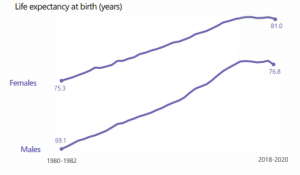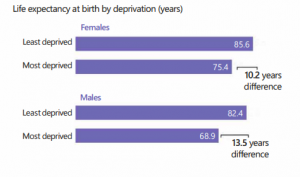According to statistics published by the National Records of Scotland, life expectancy at birth in Scotland fell in the latest year, with the average for males being 76.6 years and 80.8 years for females.
The figures for 2019-2021 continue the decrease of the previous year, which was the sharpest fall since 1980-1982.

Graph showing slight decline of life expectancy in Scotland
Yet, despite this drop, new figures indicate that the estimated number of people aged 100 or older has passed the 1,000 mark in Scotland for the first time. The latest data shows that as of June 2021, there were 1,040 people who had reached their centenary, an increase of 16% in the year to mid-2021. Commenting on these findings, Esther Roughsedge, Head of Population and Migration Statistics, said:
The number of people in the oldest age groups has been steadily increasing. This latest increase reflects the baby boom that happened in the years after World War One. The majority of people aged 100 or older are female. Four times more females than males reached this milestone – 820 females compared to 220 males – reflecting the longer life expectancy of females.
Esther Roughsedge, Head of Population and Migration Statistics
Deprivation continues to have an impact on life expectancy. In the most deprived areas of Scotland, average male life expectancy was 13.7 years lower than in the least deprived areas. For females the difference was 10.5 years. This gap has become wider in recent years and Scotland has the lowest life expectancy of all UK countries.

Life expectancy is lower in more deprived areas
Life expectancy was highest in Orkney Islands and lowest in Glasgow city for both males and females in 2019-2021, and most of Scotland’s council areas have seen life expectancy fall over the last few years. Life expectancy was higher in rural areas than in urban areas.
Of course, another chief explanation of this decrease is down to the Covid 19 pandemic. Julie Ramsay, Head of Vital Events Statistics at NRS, said:
Life expectancy has decreased by more than 11 weeks for males and almost 8 weeks for females since 2018-2020. Our analysis shows that COVID-19 deaths accounted for the vast majority of the fall in life expectancy for both males and females.
Julie Ramsay, Head of Vital Events Statistics
Background information stated by the National Records of Scotland:
- There is no register of centenarians, so the figures are estimates based on population information rolled forward from the 2011 Census. Therefore, NRS do not know who the oldest person in Scotland is.
- The estimates relate to the population as of 30th June (mid-year estimates).
- NRS uses ‘age at death’ data to build up a profile of the number of people aged 90 and over in Scotland. For example, if someone died in 2019 aged 105, it would mean that they were alive and aged 104 in 2018 and 103 in 2017 etc. By collating ‘age at death’ data, the estimates for earlier years become more accurate as more death records are available to inform these age profiles.




